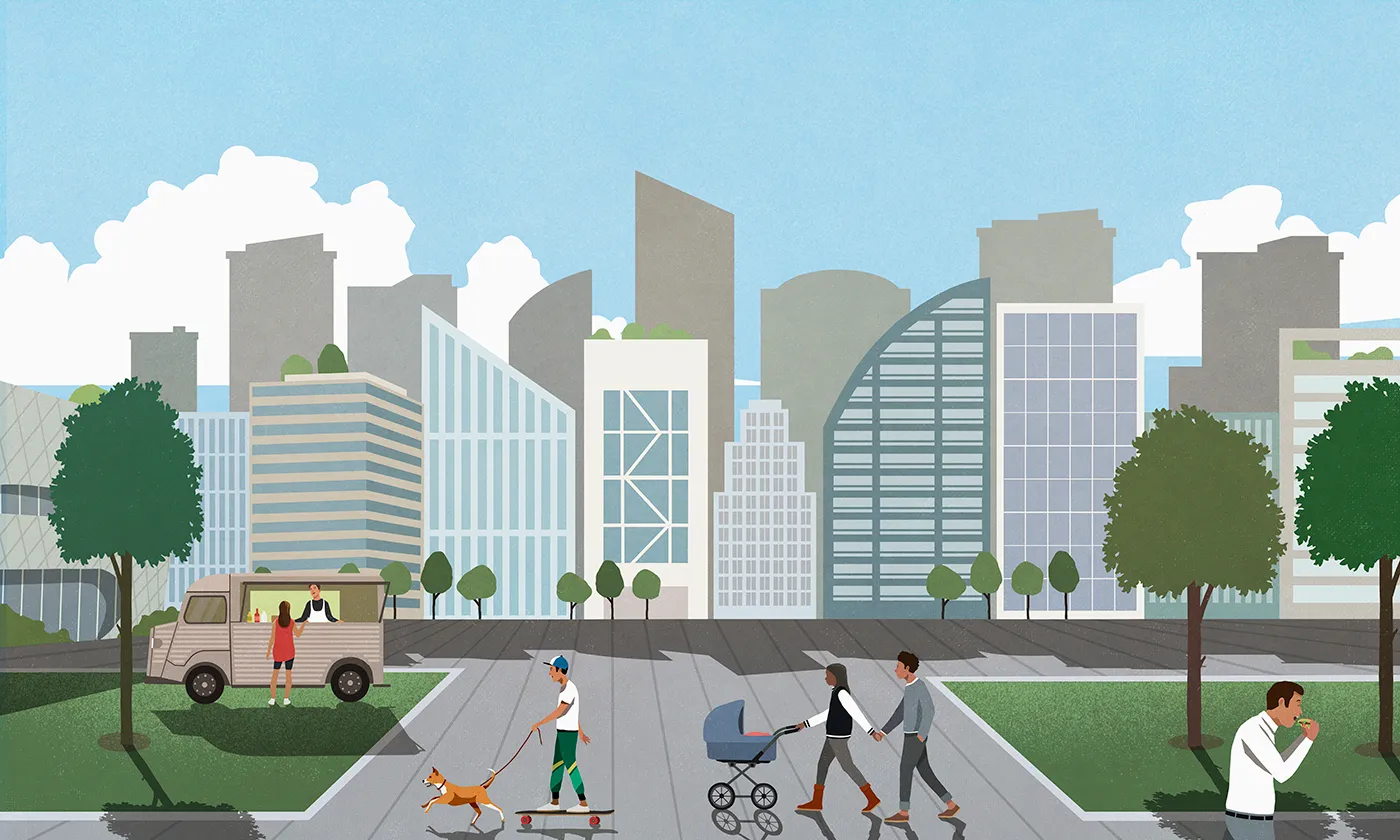Walkable Cities
Walkable cities prioritize pedestrian-friendly infrastructure, reducing reliance on cars and enhancing urban livability. These cities aim to reduce greenhouse gas emissions, improve public health, and foster vibrant communities.

15 minutes of walkable city (Yes Magazine)
View open jobs in this Solution
Example Companies
- Sidewalk Labs - Develops urban innovations to make cities more sustainable and livable.
- Culdesac - Builds car-free neighborhoods with a focus on walkability.
- UrbanFootprint - Provides urban planning software to design walkable cities.
- StreetLight Data - Uses big data to analyze and improve urban mobility.
- EcoCounter - Develops pedestrian and cyclist counting solutions to support walkable city planning.
Overview
Walkable cities focus on creating pedestrian-friendly environments that reduce reliance on cars, lower greenhouse gas emissions, and enhance urban livability. Key technologies and strategies include reflective pavement, pedestrian-centric design, and comprehensive urban planning.
Progress Made
Significant advancements have been made in creating walkable cities:
- Reflective Pavement and Paint: Reduces heat absorption and urban heat islands.
- Pedestrian-Centric Design: Prioritizes pedestrian infrastructure over car-centric planning.
- Mixed-Use Development: Integrates residential, commercial, and recreational spaces within walking distance.
Solutions by Sector
Urban Planning
- 15-Minute Cities: Ensuring all essential services are within a 15-minute walk or bike ride.
- Mixed-Use Development: Combining residential, commercial, and recreational spaces.
- Green Infrastructure: Incorporating parks and green spaces into urban planning.
Case Studies:
- Paris, France: The 15-Minute City initiative aims to ensure all residents can access essential services within a 15-minute walk or bike ride (Paris 15-Minute City).
- Portland, USA: The 20-Minute Neighborhoods program supports walkable and bikeable infrastructure (Portland 20-Minute Neighborhoods).
- Culdesac, USA: Builds car-free neighborhoods designed for walkability and community engagement (Culdesac).
Technology and Data
- Urban Planning Software: Tools for designing walkable cities.
- Big Data Analytics: Analyzing urban mobility patterns to improve walkability.
- Pedestrian and Cyclist Counting: Monitoring foot and bike traffic to inform infrastructure planning.
Case Studies:
- UrbanFootprint, USA: Provides urban planning software to design walkable cities (UrbanFootprint).
- StreetLight Data, USA: Uses big data to analyze and improve urban mobility (StreetLight Data).
- EcoCounter, France: Develops solutions for counting pedestrians and cyclists to support urban planning (EcoCounter).
Community Engagement
- Public Participation: Involving residents in the planning process.
- Tactical Urbanism: Implementing temporary changes to test and refine urban designs.
- Education and Awareness: Promoting the benefits of walkable cities.
Case Studies:
- New York City, USA: The Open Streets program provides space for pedestrians and cyclists, enhancing walkability (NYC Open Streets).
- San Francisco, USA: The Slow Streets program prioritizes pedestrian and cyclist safety (SF Slow Streets).
- Seattle, USA: The Stay Healthy Streets program closes streets to through traffic, giving space back to pedestrians and bikers (Seattle Stay Healthy Streets).
Lessons Learned
- Stakeholder Engagement: Comprehensive planning considering all stakeholders' needs is crucial.
- Community Involvement: Engaging the community in the planning process is important.
- Dedicated Funding: Having a reliable funding source is essential for successful implementation.
- Pedestrian-Centric Design: Prioritize pedestrian-friendly infrastructure and later integrate other modes of transportation.
- Safe Environment: Create safe and comfortable pedestrian environments.
Challenges Ahead
- Infrastructure Deficit: Many cities lack infrastructure supporting walking as a primary transportation mode.
- Political Will: Overcoming lack of political support for necessary changes.
- Funding Shortage: Insufficient funding for walkable cities development and implementation.
- Public Awareness: Increasing awareness about the benefits of walkable cities.
Best Path Forward
- Policy Implementation: Develop and implement policies favoring walking and discouraging driving.
- Research Investment: Increase funding for walkable cities technology research and development.
- Public Awareness: Raise awareness about the benefits of walkable cities.
- Private Sector Involvement: Encourage private sector investment in walkable cities technology.
- Collaboration: Partner with other cities and organizations dedicated to climate change mitigation.
Prominent supporters include Sidewalk Labs, Culdesac, UrbanFootprint, StreetLight Data, and EcoCounter.
Image credit: Yes Magazine